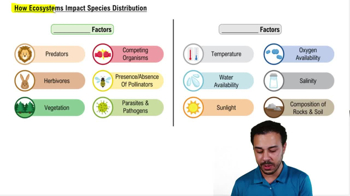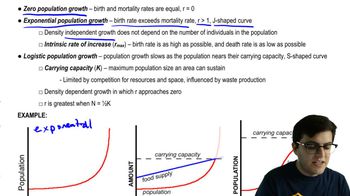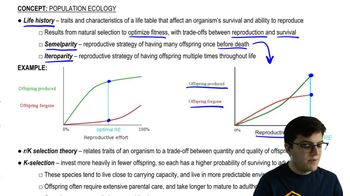Table of contents
- 1. Introduction to Biology2h 40m
- 2. Chemistry3h 40m
- 3. Water1h 26m
- 4. Biomolecules2h 23m
- 5. Cell Components2h 26m
- 6. The Membrane2h 31m
- 7. Energy and Metabolism2h 0m
- 8. Respiration2h 40m
- 9. Photosynthesis2h 49m
- 10. Cell Signaling59m
- 11. Cell Division2h 47m
- 12. Meiosis2h 0m
- 13. Mendelian Genetics4h 41m
- Introduction to Mendel's Experiments7m
- Genotype vs. Phenotype17m
- Punnett Squares13m
- Mendel's Experiments26m
- Mendel's Laws18m
- Monohybrid Crosses16m
- Test Crosses14m
- Dihybrid Crosses20m
- Punnett Square Probability26m
- Incomplete Dominance vs. Codominance20m
- Epistasis7m
- Non-Mendelian Genetics12m
- Pedigrees6m
- Autosomal Inheritance21m
- Sex-Linked Inheritance43m
- X-Inactivation9m
- 14. DNA Synthesis2h 27m
- 15. Gene Expression3h 20m
- 16. Regulation of Expression3h 31m
- Introduction to Regulation of Gene Expression13m
- Prokaryotic Gene Regulation via Operons27m
- The Lac Operon21m
- Glucose's Impact on Lac Operon25m
- The Trp Operon20m
- Review of the Lac Operon & Trp Operon11m
- Introduction to Eukaryotic Gene Regulation9m
- Eukaryotic Chromatin Modifications16m
- Eukaryotic Transcriptional Control22m
- Eukaryotic Post-Transcriptional Regulation28m
- Eukaryotic Post-Translational Regulation13m
- 17. Viruses37m
- 18. Biotechnology2h 58m
- 19. Genomics17m
- 20. Development1h 5m
- 21. Evolution3h 1m
- 22. Evolution of Populations3h 52m
- 23. Speciation1h 37m
- 24. History of Life on Earth2h 6m
- 25. Phylogeny2h 31m
- 26. Prokaryotes4h 59m
- 27. Protists1h 12m
- 28. Plants1h 22m
- 29. Fungi36m
- 30. Overview of Animals34m
- 31. Invertebrates1h 2m
- 32. Vertebrates50m
- 33. Plant Anatomy1h 3m
- 34. Vascular Plant Transport2m
- 35. Soil37m
- 36. Plant Reproduction47m
- 37. Plant Sensation and Response1h 9m
- 38. Animal Form and Function1h 19m
- 39. Digestive System10m
- 40. Circulatory System1h 57m
- 41. Immune System1h 12m
- 42. Osmoregulation and Excretion50m
- 43. Endocrine System4m
- 44. Animal Reproduction2m
- 45. Nervous System55m
- 46. Sensory Systems46m
- 47. Muscle Systems23m
- 48. Ecology3h 11m
- Introduction to Ecology20m
- Biogeography14m
- Earth's Climate Patterns50m
- Introduction to Terrestrial Biomes10m
- Terrestrial Biomes: Near Equator13m
- Terrestrial Biomes: Temperate Regions10m
- Terrestrial Biomes: Northern Regions15m
- Introduction to Aquatic Biomes27m
- Freshwater Aquatic Biomes14m
- Marine Aquatic Biomes13m
- 49. Animal Behavior28m
- 50. Population Ecology3h 41m
- Introduction to Population Ecology28m
- Population Sampling Methods23m
- Life History12m
- Population Demography17m
- Factors Limiting Population Growth14m
- Introduction to Population Growth Models22m
- Linear Population Growth6m
- Exponential Population Growth29m
- Logistic Population Growth32m
- r/K Selection10m
- The Human Population22m
- 51. Community Ecology2h 46m
- Introduction to Community Ecology2m
- Introduction to Community Interactions9m
- Community Interactions: Competition (-/-)38m
- Community Interactions: Exploitation (+/-)23m
- Community Interactions: Mutualism (+/+) & Commensalism (+/0)9m
- Community Structure35m
- Community Dynamics26m
- Geographic Impact on Communities21m
- 52. Ecosystems2h 36m
- 53. Conservation Biology24m
50. Population Ecology
Introduction to Population Ecology
Problem 10c
Textbook Question
Make a rough sketch of the age distribution in a developing versus a developed country, and explain why the shapes of the diagrams are different. How is AIDS, which is a sexually transmitted disease, likely affecting the age distribution in countries hard hit by the epidemic?
 Verified step by step guidance
Verified step by step guidance1
Identify the typical age distribution shapes for developing and developed countries. Developing countries usually have a broad base pyramid shape indicating a high birth rate and a larger proportion of young people. Developed countries typically have a more rectangular or even inverted pyramid shape, indicating lower birth rates and a higher proportion of older individuals.
Examine the factors influencing these shapes. In developing countries, higher fertility rates and lower life expectancy shape the pyramid, while in developed countries, lower fertility rates and higher life expectancy lead to a more even distribution or a top-heavy pyramid.
Sketch the age distribution diagrams based on these characteristics. For a developing country, draw a wide base that narrows sharply with increasing age. For a developed country, draw a more uniformly wide shape across younger age groups that narrows slightly or remains stable into older age groups.
Discuss how AIDS affects age distribution in countries with high incidence rates. AIDS disproportionately affects young to middle-aged adults, leading to a higher mortality rate in these age groups. This creates gaps or indentations in the age distribution pyramid around the affected age groups, altering the typical shape.
Reflect on the broader implications of these differences in age distribution. Consider how they affect economic productivity, dependency ratios, and social services needs in both developing and developed countries, especially with the impact of diseases like AIDS.
Recommended similar problem, with video answer:
 Verified Solution
Verified SolutionThis video solution was recommended by our tutors as helpful for the problem above
Video duration:
2mPlay a video:
Was this helpful?
Key Concepts
Here are the essential concepts you must grasp in order to answer the question correctly.
Age Distribution
Age distribution refers to the proportion of individuals of different ages within a population. It is typically represented in a population pyramid, where the shape can indicate demographic trends. In developing countries, the pyramid often has a broad base, indicating a high birth rate and a youthful population, while developed countries tend to have a more rectangular shape, reflecting lower birth rates and an aging population.
Recommended video:
Guided course

How Ecosystems Impact Species Distribution
Impact of AIDS on Demographics
AIDS significantly impacts the age distribution in countries heavily affected by the epidemic, particularly among young adults. The disease primarily affects individuals in their reproductive years, leading to a decrease in the working-age population and a skewed age distribution. This results in a higher proportion of younger and older individuals, as the middle age group is disproportionately affected by mortality due to AIDS.
Recommended video:
Guided course

Population Demography
Developed vs. Developing Countries
Developed countries typically have higher levels of income, education, and healthcare, leading to lower birth and death rates. In contrast, developing countries often experience higher fertility rates and lower life expectancy due to limited access to healthcare and education. These differences contribute to distinct age distribution patterns, with developed nations showing more balanced age structures and developing nations exhibiting youthful populations with rapid growth.
Recommended video:
Guided course

Embryonic Plant Development

 1:17m
1:17mWatch next
Master Population Ecology with a bite sized video explanation from Jason Amores Sumpter
Start learningRelated Videos
Related Practice



































































